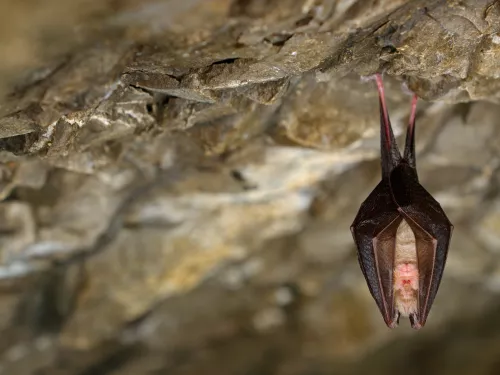
Lesser horseshoe bat
The lesser horseshoe bat was once a cave-dweller, but now tends to roost in old buildings, such as stables and barns. It is rare in the UK and, like many other bats, declining in number.

The lesser horseshoe bat was once a cave-dweller, but now tends to roost in old buildings, such as stables and barns. It is rare in the UK and, like many other bats, declining in number.
Traditionally a small finch of woodland and scrub, it appears that the lesser redpoll is now moving into our gardens. It has a streaky brown body, red forehead and black bib, and mostly feeds on seeds.
Traditionally a coastal species, Lesser sea-spurrey has spread inland, taking advantage of the winter-salting of our roads. Its pink-and-white flowers bloom in summer.
So-named for its spear-like leaves, Lesser spearwort can be found along the edges of ponds, lakes and streams, and in marshes and wet meadows. As a buttercup, it displays familiar, butter-yellow flowers.

The lesser spotted woodpecker is the smallest of the UK's woodpeckers. Listen out for its drumming, which is quieter than that of the great spotted woodpecker, in woodland, parks , orchards and gardens.
The lesser stag beetle may be smaller than its famous cousin, but it is still a large beetle with large jaws. It can be seen in woods, parks and hedgerows during summer, and depends on dead wood.
Look for the pretty, star-shaped, white flowers of Lesser stitchwort in woodlands and meadows, and along hedgerows and roadside verges in spring. Its flowers are smaller than those of Greater stitchwort.
Similar to the Common backswimmer, the Lesser water boatman has oar-like legs to help it swim, but it does not swim upside-down. It is herbivorous and can be found at the surface of ponds, lakes and ditches.
Look out for the white, umbrella-like flower heads of lesser water-parsnip along the shallow margins of ditches, ponds, lakes and rivers. When crushed, it does, indeed, smell like parsnip!

One of the only venomous fish to be found in British waters, the lesser weever fish is certainly one to watch out for!
The lesser whitethroat is smaller than its cousin, the whitethroat, and sports dark cheek feathers that give it a 'mask'. Most likely to be heard around woodland and scrub, rather than seen.
The Leyland cypress, or 'Leylandii', is a notorious tree that has been widely planted for its fast-growing nature. It easily can get out of control, shading gardens at the expense of native plants.